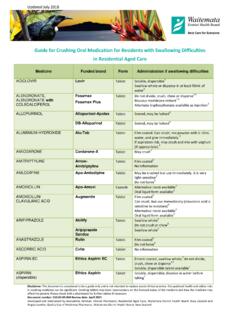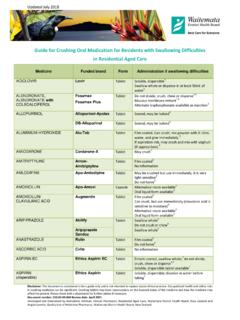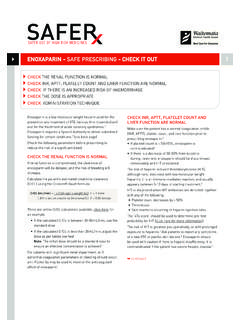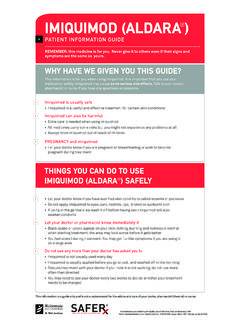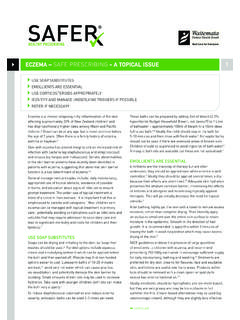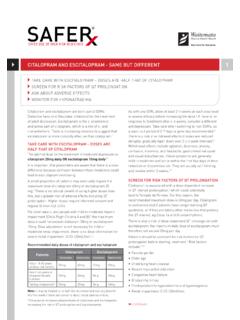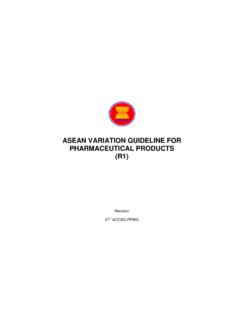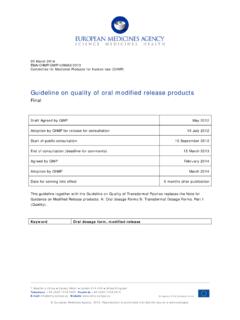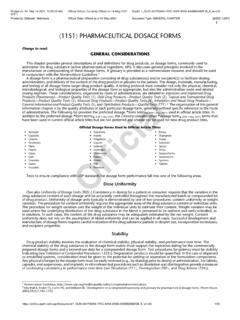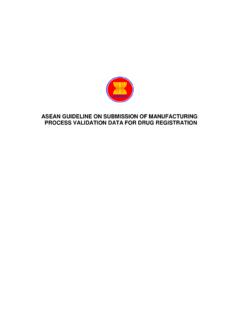Transcription of Crushing guide for oral medication - SafeRx
1 Disclaimer: This document is considered to be a guide only and is not intended to replace sound clinical practice. Occupational health and safety risks in Crushing medicines can be significant. Crushing tablets may have repercussions on the licensed status of the medicine and how the medicine may affect the patient. Please check with a pharmacist for further advice if necessary. Document number: 010-03-09-004 Review date: April 2021 Developed and maintained by: Bernadette Rehman, Clinical Pharmacist, Residential Aged Care, Waitemata District Health Board, New Zealand and Angela Lambie, Quality Use of Medicines Pharmacist, Waitemata District Health Board, New Zealand Crushing guide for oral medication in Residential Aged Care This is to guide decisions about Crushing oral medicines for residents who have swallowing difficulties in Residential Aged Care. Before Crushing please consider: Alternative medicines/formulations/routes Assessment of swallowing Some medicines should not be crushed because this will alter the absorption or stability of the medicine or it may cause a local irritant effect or unacceptable taste.
2 Sometimes the exposure of powder from Crushing medicines may cause occupational health and safety risks to staff. Crushing or altering the medicine is often outside the product licence. Effect of Crushing tablets important examples1 Preparation type Abbreviations Notes Examples modified release Long acting Controlled release Extended release Slow release Controlled delivery Prolonged release LA, CR, XR, SR, CD, XL May have Retard , Slow or Continuous in the title Do not crush or chew This medicine is designed to be released slowly (Long acting) If crushed, the resident may receive the full dose faster than expected Diltiazem CD Metoprolol CR Felodipine ER Sinemet CR Enteric Coated Usually has EN or EC in the medicine name Do not crush The coating may protect the stomach or ensure drug delivery beyond the stomach Aspirin EC Mesalazine EC Film and sugar coated Usually has FC in the medicine name Do not crush (preferably) The coating may be necessary to prevent rapid degradation of the medicine or to mask the taste Doxycycline (Doxine) Morphine sulphate (Sevredol) Cilalopram (PSM)
3 Pre-scored tablets Tablets that have a score line May be broken along the score line to give half doses, but may not necessarily be crushed Isosorbide mononitrate SR (Duride) Carbamazepine CR (Tegretol CR) Cytotoxic or other If crushed, the drug powder may be exposed to staff and cause occupational health or safety risk Methotrexate Finasteride Note: When switching to a liquid or alternative formulation, there may be a difference in the bioavailalbity of the medicine do not assume that the dose will be the same. Avoid sprinkling crushed tablets or capsule contents onto meals because the meal may remain uneaten. Disclaimer: This document is considered to be a guide only and is not intended to replace sound clinical practice. Occupational health and safety risks in Crushing medicines can be significant. Crushing tablets may have repercussions on the licensed status of the medicine and how the medicine may affect the patient.
4 Please check with a pharmacist for further advice if necessary. Document number: 010-03-09-004 Review date: April 2021 Developed and maintained by: Bernadette Rehman, Clinical Pharmacist, Residential Aged Care, Waitemata District Health Board, New Zealand and Angela Lambie, Quality Use of Medicines Pharmacist, Waitemata District Health Board, New Zealand Sugar coating2 A sugar coating is a hard coating of sugar surrounding the tablet. This is often used to hide the flavour of unpleasant or bitter tasting medicines eg ibuprofen. Sugar coating can also prevent light or moisture from affecting the drug's stability. Film coating2 Film coatings are very thin layers of an inactive agent coated onto the tablet to protect the tongue from the flavour of the contents, or the contents from moisture and light. The film will breakdown in the stomach by saliva or stomach acid. Film coatings do not significantly affect the way in which the drug is absorbed.
5 Crushing tablets with film or sugar coatings may not affect how the medicine is released but may cause an unpleasant taste. Enteric Coating2 Tablets with an 'enteric coating' (EC) usually means that there is a coating which holds the tablet together in acid conditions, such as the stomach, and release the medicine contents in the intestines. Enteric coatings are either used to protect the stomach from the medicine, to protect the medicine from the stomach, or to release the medicine after it has passed through the stomach eg in the intestines. Medicines that can be corrosive to the stomach and lead to stomach ulcers, such as aspirin, diclofenac and naproxen often have enteric coatings. Omeprazole is broken down in acidic environments and has an enteric coating around the granules inside the capsules. Sulfasalazine is used either for the treatment of arthritis or for the treatment of Crohn's disease which is inflammation of the intestines.
6 When used for arthritis it is very often given without an enteric coating so that it can be absorbed more quickly, whereas for Crohn's where it is needed in the intestines to work it is given with an enteric coating. To retain these characteristics, enteric coated medicines should not be crushed. modified release (Long acting)2 modified release medicines have been developed to slow down the release of the medicine so that it does not need to be taken too often, and so improves compliance. When the release of the medicine is slowed, there is less fluctuation in blood levels, which may lead to extended periods of effectiveness. These tablets and capsules often have the letters MR, LA, CD, CR or SR in their names. Sometimes the words 'slow' or 'retard' can be used. There are a number of ways in which a medicine can have its release modified . Sometimes the pellets inside the capsule are of different thicknesses and therefore the thinnest release the drug first and the thickest last (Figure 1).
7 Another method is to put the medicine into a thick substance which breaks down slowly and releases the drug slowly. Alternatively a non-dissolving coating is placed around the tablet or capsule, with a small hole so the medicine is only released through the hole. If modified release products are crushed, the whole dose will be released very quickly and could be dangerous. modified release products should never be crushed or modified . Dispersing tablets or capsule contents3 If tablets or capsules are able to be dispersed, it is best to put the tablet (or capsule contents) into mortar or medicine cup. Then add 5 to 10mL of water and allow the tablet to disperse. This may take several minutes, and gentle shaking or stirring may be required. It is best to give the solution immediately. Always ensure that the correct portion is given. References 1. Wright D, Chapman N, Foundling-Miah M et al. Consensus guideline on the medication management of adults with swallowing difficulties.
8 Medendium Group Publishing Ltd. 2006. 2. Wright D. (Accessed 12-04-18) 3. Society of Hospital Pharmacists of Australia. Don t rush to crush handbook. First edition; December 2011; ISBN 978-0-987-1103-3-6
